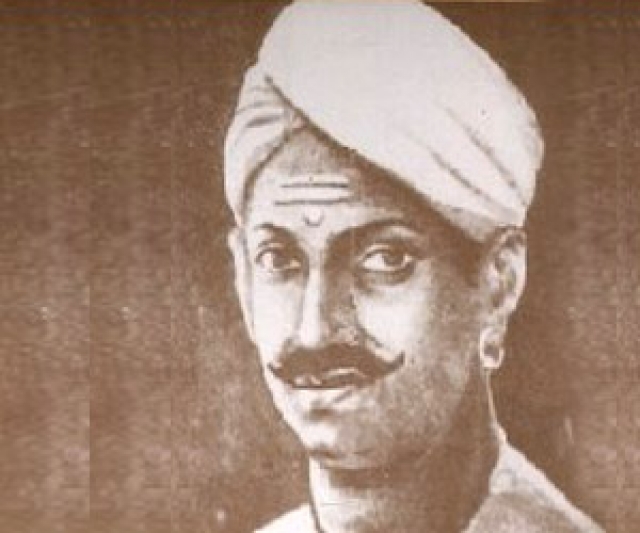Mangal Pandey was an Indian soldier who played a key part in events immediately preceding the outbreak of the Indian rebellion of 1857. He was a sepoy (sipahi) in the 34th Bengal Native Infantry (BNI) regiment of the British East India Company. While contemporary British opinion considered him a traitor and mutineer, Pandey is widely regarded as a hero in modern India. In 1984, the Indian government issued a postage stamp to commemorate him. His life and actions have also been portrayed in several cinematic productions.
Mangal Pandey was born on 19 July 1827 in a Brahmin family in Nagwa, a village of upper Ballia district, Uttar Pradesh. He had joined the East India Company’s army in 1849. Pandey was a soldier in the 6th Company of the 34th Bengal Native Infantry and is primarily known for his involvement in an attack on several of the regiment’s officers. This incident marked an opening stage in the Indian rebellion of 1857, and paved the way for his death.
The 1857 incident
At Barrackpore on the afternoon of 29 March 1857, Lieutenant Baugh, Adjutant of the 34th Bengal Native Infantry (BNI), was informed that several men of his regiment were in an excited state. Further, it was reported to him that one of them, Mangal Pandey, was pacing in front of the regiment’s guard room by the parade ground, armed with a loaded musket, calling upon the men to rebel and threatening to shoot the first European that he set eyes on. Baugh immediately buckled on his sword, placed loaded pistols in his holsters, mounted his horse, and galloped to the lines. Pandey took position behind the station gun, which was in front of the quarter-guard of the 34th, took aim at Baugh and fired. He missed Baugh, but the bullet struck his horse in the flank, and horse and rider were brought down. Baugh quickly disentangled himself and, seizing one of his pistols, advanced towards Pandey and fired. He missed. Before Baugh could draw his sword, Pandey attacked him with a talwar (a heavy Indian sword) and closing with the adjutant, slashed Baugh on the shoulder and neck and brought him to the ground. It was then that another sepoy, Shaikh Paltu, intervened and tried to restrain Pandey even as he tried to reload his musket.
English Sergeant-Major Hewson, had arrived on the parade ground, summoned by a native officer, before Baugh. He had ordered Jemadar Ishwari Prasad, the Indian officer in command of the quarter-guard, to arrest Mangal Pandey. To this, the jemadar stated that his NCOs had gone for help and that he could not take Pandey by himself. In response Hewson ordered Ishwari Prasad to fall in the guard with loaded weapons. In the meantime, Baugh had arrived on the field shouting ‘Where is he? Where is he?’ Hewson in reply called out to Baugh, ‘Ride to the right, sir, for your life. The sepoy will fire at you! At that point Pandey fired.
Hewson had charged towards Pandey as he was fighting with Lieutenant Baugh. While confronting Pandey, Hewson was knocked to the ground from behind by a blow from Pandey’s musket. The sound of the firing had brought other sepoys from the barracks; they remained mute spectators. At this juncture, Shaikh Paltu, while trying to defend the two Englishmen called upon the other sepoys to assist him. Assailed by other sepoys, who threw stones and shoes at his back, he called on the guard to help him hold Pandey, but they threatened to shoot him if he did not let go of the mutineer.
Some of the sepoys of the quarter-guard then advanced and struck at the two prostrate officers. They then threatened Shaikh Paltu and ordered him to release Pandey, whom he had been vainly trying to hold back. However, Paltu continued to hold Pandey until Baugh and the sergeant-major were able to get up. Himself wounded by now, Paltu was obliged to loosen his grip. He backed away in one direction and Baugh and Hewson in another, while being struck with the butt ends of the guards’ muskets.
In the meantime, a report of the incident had been carried to the commanding officer General Hearsey, who then galloped to the ground with his two officer sons. Taking in the scene, he rode up to the guard, drew his pistol and ordered them to do their duty by seizing Mangal Pandey. The General threatened to shoot the first man who disobeyed. The men of the quarter-guard fell in and followed Hearsey towards Pandey. Pandey then put the muzzle of the musket to his chest and discharged it by pressing the trigger with his foot. He collapsed bleeding, with his regimental jacket on fire, but not mortally wounded.
Pandey recovered and was brought to trial less than a week later. When asked whether he had been under the influence of any substances, he stated steadfastly that he had mutinied on his own accord and that no other person had played any part in encouraging him. He was sentenced to death by hanging, along with Jemadar Ishwari Prasad, after three Sikh members of the quarter-guard testified that the latter had ordered them not to arrest Pandey.
Mangal Pandey’s execution was scheduled for April 18, but was carried out ten days before that date. Jemadar Ishwari Prasad was executed by hanging on April 21.
(Ref : https://en.wikipedia.org/wiki/Mangal_Pandey & www.towardsfreedom.in)
